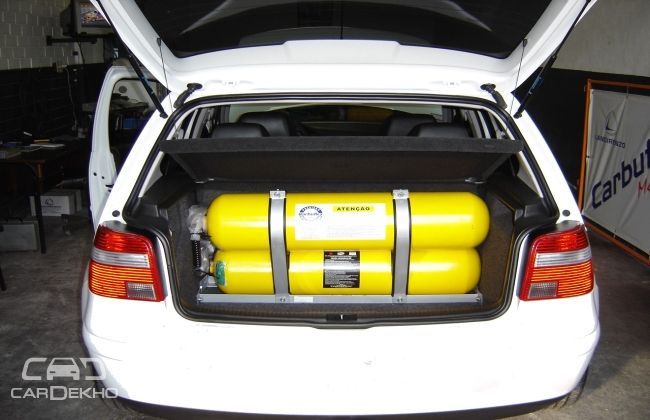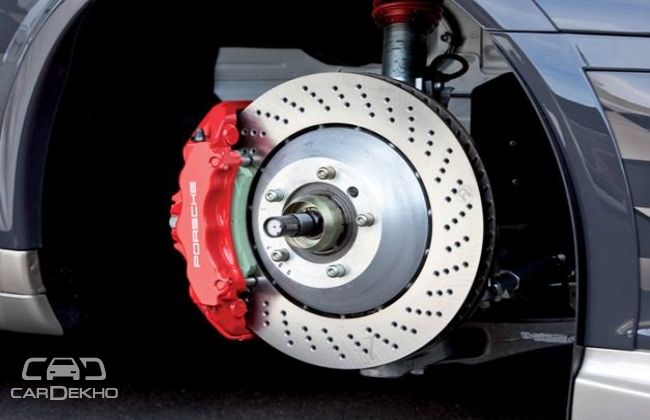CNG Kits and their Types
Modified On Apr 13, 2016 12:14 PM By CarDekho
- 69.4K Views
- 78 Comments
- Write a comment
Just like the never-ending hikes in petrol prices a few years back had brought about a revolutionary change in the Indian auto-industry in the form of diesel cars, the present-day hikes in the prices of both petrol and diesel, that do not seem like they would be slowing down anytime soon, are paving the way for yet another revolution for the automotive industry of India - this time in the form of CNG-powered automobiles.
Advantages of CNG over other Fuel Options
Much cheaper than conventional fuel options like petrol and diesel, CNG goes way beyond the domains of cost-effectiveness in its advantages. Besides being exceptionally pocket-friendly, there are a lot of other benefits that this relatively newer fuel option has to offer its users. Starting with safety, which happens to be one of the most important factors whenever it comes to vehicles of any kind, Compressed Natural Gas (CNG) proves to be a much safer alternative than both petrol and diesel thanks to a high auto-ignition temperature and an extremely narrow range of flammability that prevents it from accidentally catching fire on hot surfaces, thereby cutting down the chances of unexpected mishaps.

And the fact that CNG produces 1.6 times the energy as petrol with the same amount of fuel does not hurt either. What’s more, the pollutants that result from the combustion of this gaseous fuel, be it carbon dioxide (CO2), unburned hydrocarbons (UHC), carbon monoxide (CO), particulate matter (PM) or any other type of pollutant for that matter, are lesser in quantity by as much as 40% in comparison to other available alternatives. So, in short, in the form of CNG we are getting a fuel option that is not only cheaper but also cleaner, safer and much more efficient than what we have been using till date. Considering all this, it does not seem like much of a wondrous situation if the Indian car-market is witnessing a colossal drift towards CNG-driven vehicles.
CNG Kits
CNG, being the better fuel option that it is in comparison to petrol and diesel, is in huge demand these days, and there are two ways in which an Indian buyer can opt for it; either a buyer can bring home a brand new, original CNG car with a factory-fitted CNG kit sitting under its hood, or they can get their petrol car converted suitably so that it would now run on a dual-fuel system by means of a retro-fitted CNG kit. As far as the factory-fitted kind are concerned, they can be easily chosen according to personal preferences from a wide range of CNG vehicles that even prominent auto-brands are offering these days in their most popular fleets of automobiles. However, when it comes to the retro-fitted types, there are a number of important things that need to borne in mind by the buyer to ensure that they get the best in terms of safety, performance, efficiency and value-for-money. Here are a few simple pointers that can greatly help first time buyers of CNG kits:
- Before actually going for the conversion of a petrol car into a dual-fuel automobile, it must be known that not all petrol cars have mechanicals compatible with CNG fuel systems.
- Only those cars that have been included in the ‘CNG Approved’ listing of the Registering Authority of the state or union territory under which the buyer’s car has been registered are eligible for conversion from petrol to CNG in that geographical area, and only those are the cars that can get their Registration Certificate (RC) branded with the ‘fuel change’ seal, which is mandatory as per the laws of the Indian Government.
- Putting together those CNG kits that are imported from Italy, Argentina and China with those that are manufactured in India itself, there are a large number (more than 20) of CNG kit brands available in the country’s market, and selecting the best out of all these is probably the biggest challenge that a buyer faces at present.
- At least 20 of these available brands have been included in the Government listing of ‘Approved CNG kits’ after being assessed by the RTO itself, and are considered as the best and the safest alternatives of today. Some of these government-approved marques are Landi-Renzo, Zavoli, Tomasetto, Lovato Autogas, Longas, Tartarini, BRC, Bedni, Bugatti, Unitax and SKN. . All these brands have tie-ups with different car dealerships in the country, and therefore, before making the actual purchase, it becomes extremely important for the buyer to have a look at all the options that are being put forward by various car dealers and choose only what is best for them.
- Instead of restricting themselves to a particular automaker’s dealership network, which is bound to offer them only a limited number of options in CNG kits (according to their tie-ups with CNG kit brands), buyers can also strike a deal with independent garages or service stations that usually have a wider range of CNG kits manufactured by a large number of different manufacturers. However, in this case, before getting the conversion done, it must be ensured that the service station is a trusted source/provider of auto-parts and that its customer feedback is positive in general.
- Be it a specific dealership or an independent garage, the buyer must always remember that it is the duty of the supplier of the CNG kit to get all the paperwork done for them including the stamping of the RC with the ‘fuel change’ seal along with everything else.
Types of CNG Kits
There are basically two types of classifications that are found in CNG kits:
- One, which classifies them as Venturi kits and Sequential kits
- and the other, which classifies them as Open-loop systems and Closed-loop systems
Venturi CNG Kits
Simple in design as well as in principle, a Venturi CNG kit is one that pumps a fixed volume of gaseous fuel into the intake manifold of the car’s engine depending on the throttle input. Working like a carburetor at all times, this particular kind of CNG kit is not only cheaper and less complicated than the sequential types but is also very versatile and can be employed to work for all sorts of automobiles, irrespective of whether they are carburetor-driven or fuel-injected. Coupling of such Venturi CNG kits with an additional ECU (Electronic Control Unit) is also purely optional and depends entirely on the buyer’s choice.
Advantages: The biggest advantage that a Venturi CNG kit presents before its buyers is cost-effectiveness; it comes with a much smaller cost of installation as compared to its Sequential counterparts. Not only that, due to absence of additionals like ECU and a complex wiring, the process of installation also gets much simpler for these kits.
Disadvantages: As far as the disadvantages are concerned, first and foremost, the constant nature of fuel volume that this CNG kit exhibits can result in problems like occasional stalling and slow pick-up whenever the volume of fuel in the system exceeds the upper prescribed limit or drops below the lower prescribed limit. Also, the accuracy of this particular kit is not known to be the best and hence frequent tuning and cleanups are required to keep the system in good shape, which can be a bit tiresome for some people.
Sequential CNG Kits
Much more accurate in their operation as compared to Venturi CNG kits, Sequential CNG kits are those systems that maintain a well-controlled flow of fuel into the intake manifold of the car’s engine. To intelligently monitor and control the flow of CNG into the intake manifold, a distinct ECU along with special injectors for CNG are employed for such systems so as to create an efficient working environment for the CNG system similar to the one used for petrol systems.
Advantages: There are a number of critical benefits that can be availed by the use of a Sequential CNG kit, some of which are accuracy in CNG injection, better mileage and impressive performance, all thanks to the ability of this CNG kit to vary the volume of fuel in the system according to the driving requirements.
Disadvantages: As for the disadvantages of Sequential CNG kits, the most prominent one is that of a higher cost of ownership, sometimes even twice as high as that for a Venturi CNG kit. Also, the installation process is a lot more complicated for these systems. Plus, these types of CNG kits can be installed only in those cars that come with an electronic fuel injection system, which restricts their scope considerably.
Closed-loop Systems
Aimed at keeping the flow of fuel well within optimum limits, a closed-loop system is that which comes equipped with Oxygen sensors, also known as Lambda sensors, in the exhaust system that work to monitor the exhaust emissions of the car and send the feedback to the ECU that controls the gas flow so as to minimise the harmful emissions let out by the vehicle, thereby keeping a check on automobile pollution.
Advantages: Keeping the harmful emissions under control, this particular kind of system plays a significant role in cutting down air-pollution. In addition to that, the well-controlled flow of fuel that takes place from the CNG kit to the engine’s intake manifold helps in obtaining a better fuel-economy.
Disadvantages: The only notable drawback that is seen in closed-loop systems appears when a performance-crazy fanatic sits behind the wheel of the car. And that is because the careful check that this system maintains on gas flow tends to bring the performance level down, not allowing the fuel volume to vary according to the driving requirements.
Open-loop Systems
When there are no Oxygen or Lambda sensors present in the system that could send a feedback from the exhaust, such a system is known as an open-loop system.
Advantages: The biggest advantage of this kind of a system is for those who prefer performance-oriented vehicles. Since there is no check whatsoever on the flow of gas in such systems, fuel is allowed to flow as the driver wants it to, resulting in a much better performance and pick-up. Also, since Oxygen and Lambda sensors are not required in open-loop systems, their cost can be eliminated from the total ownership cost of the CNG kit, which makes the entire thing a much more affordable buy.
Disadvantages: Firstly, unchecked emissions that are let out by open-loop systems tend to cause much graver damage to the environment than closed-loop systems. Secondly, these increased emissions also result in excessive heat generated in the car’s engine, which can cause severe damages to its valves. After taking all the aspects of CNG kits and conversions into account, all that can be said in conclusion is that before going for a conversion from petrol to CNG fuel systems, the rules and regulations of the government, and the trustworthiness of both the dealers and the parts should be carefully taken into consideration by the buyer. Once that has been done, the buyer needs to intelligently pick the best option for themselves depending on the characteristics, advantages and disadvantages of the different varieties of CNG kits available in the market so that they don't have to regret their decision in future.
1 out of 1 found this helpful










